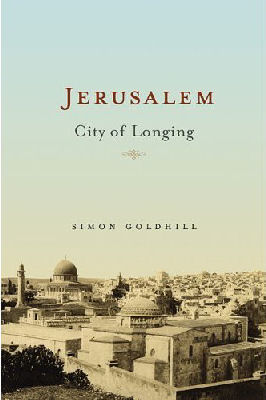
|
Posted June 4, 2008
Book: Jerusalem: City of Longing Author: Simon Goldhill The Belknap Press of Harvard University Press. Boston, Massachusetts. Pp. 342 An Excerpt from the Jacket:
But Jerusalem is more than a tourist site — it is a city where every square mile is layered with historical significance, religious intensity, and extraordinary stories. It is a city built by each ruling Empire in its own way: the Jews, the Romans, the Christians, the Muslims, and for the past sixty years, the modern Israelis. What makes Jerusalem so unique is the heady mix, in one place, of centuries of passion and scandal, kingdom-threatening wars and petty squabbles, architectural magnificence and bizarre relics, spiritual longing and political cruelty. It is a history marked by three great forces: religion, war, and monumentality. In this book, Simon Goldhill takes on this peculiar archaeology of human imagination, hope, and disaster to provide a tour through the history of this most image-filled and ideology-laden city — from the bedrock of the Old City to the towering roofs of the Holy Sepulchre. Along the way, we discover through layers of buried and exposed memories – the long history, the forgotten stories, and the lesser-known aspects of contemporary politics that continue to make Jerusalem one of the most embattled cities in the world. An Excerpt from the Book: The City of David: The Lure of the Stones The City of David, a tiny town by any modern considerations, was built on a low ridge surrounded by the Kidron Valley to the east and the Tyropoeon to the west, with the Hinnom Valley further to the south and west. When Solomon built the Temple the city stretched further up the ridge onto Mount Moriah. The Gibon Spring produced enough water, just about, for the town’s immediate needs, expanded by the collection of rainwater in cisterns. Without the Gihon it would have been impossible to settle this part of the mountains, and the position of the earliest city on what was otherwise neither the most defensible nor the most pleasant ridge was determined by the water supply. By the eighth century B.C. at least King David’s city had expanded over to the western hill — hence that stretch of the eighth-century wall visible in the Old City. The western hill is still usually called Mount Zion because that is where it was assumed for many years the first city was built, though now everyone agrees that the first settlement was on the eastern hill: old names die hard. This easter hill is the space of the oldest city, the city of the First Temple, and its remains are now a fascinating and still changing archaeological park, the Ir David complex. Table of Contents: 1. The center of the Christian world 2. The center of Jewish Jerusalem 3. The center of Muslim Jerusalem 4. The old city 5. The oldest city 6. The Victorian city 7. The modern city |
|
